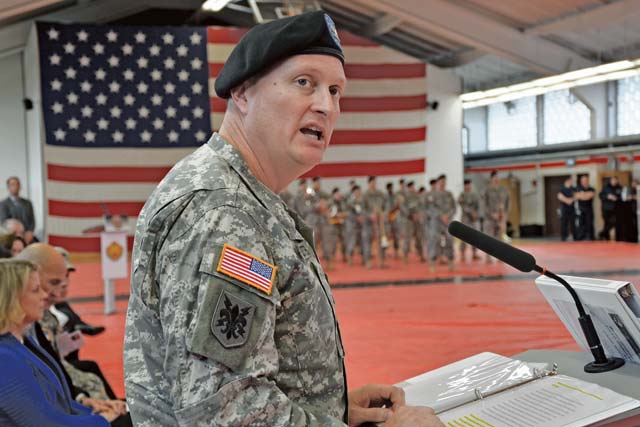
The Army closed a chapter in its history Sept. 26 at Kleber Kaserne, furling colors of two Army garrisons and opening one anew — U.S. Army Garrison Rheinland-Pfalz.
The ceremony marked an end to the U.S. Army’s garrisons in Heidelberg and Mannheim, with the casing of U.S. Army Garrison Baden-Württemberg’s colors. Meanwhile, U.S. Army Garrison Kaiserslautern was redesignated as U.S. Army Garrison Rheinland-Pfalz.
“This is a great opportunity to right size the U.S. Army garrison presence here from battalion level to brigade level and to make the naming convention more inclusive of the full breadth of the communities we support,” said Col. Bryan DeCoster, U.S. Army Garrison Rheinland-Pfalz commander. “Other than seeing the names change — many people have seen new signs going up — this should be a seamless process for our Soldiers, civilians and family members.”
The garrison’s footprint will include 27 posts spread across the region, from Pirmasens and Miesau to Baumholder and Germersheim. The combined U.S. Army and U.S. Air Force presence in Rheinland-Pfalz remains the largest American military community overseas.
At the event, the U.S Army Europe Band played ceremonial music as Soldiers from the garrison’s headquarters detachment joined U.S. Army Garrison Baumholder Soldiers in formation. Senior leaders from the KMC attended, as did several local German dignitaries.
Lt. Col. George Brown, the garrison’s emergency services director, and Command Sgt. Maj. Scott Creighton, USAG Baumholder’s senior enlisted leader, cased USAG Kaiserslautern’s colors. DeCoster and Command Sgt. Maj. Kenneth Kraus cased USAG Baden-Württemberg’s colors and raised a new flag for USAG Rheinland-Pfalz.
In June, Lt. Col. Lars Zetterstrom relinquished command of the Kaiserslautern garrison to DeCoster, who moved his headquarters from Heidelberg to Kaiserslautern. DeCoster’s position is unique, as the last commander of USAG Baden-Württemberg in Heidelberg and the first commander of USAG Rheinland-Pfalz in Kaiserslautern.
“It is important that we never forget the past while moving toward the future,” DeCoster said.
Kaiserslautern has a long tradition as a garrison town. Before World War I, German troops were posted in the city’s kasernes. Later, French troops occupied the area. Prior to World War II, German troops were again garrisoned in the city. Afterward, U.S. and French troops remained. The area has been a major U.S. military hub for both the Army and Air Force since the 1950s.
The 415th Base Support Battalion — the forerunner to the current garrison — stood up in 1992. In 2005, it became USAG Kaiserslautern, with posts also in Miesau, Pirmasens and Landstuhl. The garrison supports dozens of tenant units, including the 21st Theater Sustainment Command, the 7th Civil Support Command, Landstuhl Regional Medical Center and the 10th Army Air and Missile Defense Command, among others. Several other Defense Department agencies call the garrison home.
The garrison acquired Sembach Kaserne in 2010, Grünstadt Depot in 2011 and Germersheim Army Depot in 2012. The garrison continues to grow. Ongoing U.S. Army projects include new schools and barracks construction in Kaiserslautern, family housing renovation in Baumholder and the construction and renovation of a distribution warehouse in Germersheim.
Army installations in Germany today reflect a focus on the future, said Kathleen Marin, Installation Management Command-Europe region director.
“We are taking constellations of obsolete and inefficient facilities and consolidating them into sustainable hubs of activity,” Marin said.
Sembach Kaserne, now the headquarters of IMCOM-E, European Regional Medical Command, 30th Medical Brigade, U.S. Army NATO Brigade and the 18th Military Police Brigade, serves as an example of that change, she said. Once a U.S. air base with a Cold War mission, the revitalized post now supports Army garrisons across Europe.
Marin also spoke of the long-standing relationship between Americans and Germans of Rheinland-Pfalz, many of whom settled in Pennsylvania, New York, Wisconsin and North Carolina, she said. Most well known are the Amish, whose dialect of German originates in Rheinland-Pfalz.
“Our shared history shows that our bond extends not for decades, but for centuries,” Marin said. “That is why I am honored to mark another milestone in our shared heritage by designating our presence here — U.S. Army Garrison Rheinland-Pfalz.”


